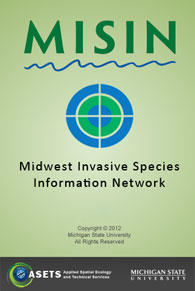
THINKING FORWARD: PRE-SEASON INVASIVE ALERT
As the blistery months continue to roll on through, thinking about spring and the warmer weather brings anticipation for much needed yard work, trimmings; ditch clean ups, and house cleanings. But before you get into all of that be aware of your yard and any invasives that may be in the area. Spring time can be one of the best times for removal of certain invasives, as well as a time for spread. So when you get out there with your sheers and pruners, know what you’re trimming and the proper techniques available for best removal and control methods. If you’re a landowner regularly surveying your property for new and unusual plant growth is a great first step for prevention and spread control of unwelcomed species.
 Eradicating invasive species on site is not impossible and is generally an attainable goal, especially if the introduction of the species is detected early on, but keep in mind that eradication may not be feasible if the population is large and pervasive. If that’s the case, then a more realistic management goal to control the unwanted species can be attained by reducing their density and abundance to a level that doesn’t compromise the integrity of the ecosystem and allows the native species to thrive.
Eradicating invasive species on site is not impossible and is generally an attainable goal, especially if the introduction of the species is detected early on, but keep in mind that eradication may not be feasible if the population is large and pervasive. If that’s the case, then a more realistic management goal to control the unwanted species can be attained by reducing their density and abundance to a level that doesn’t compromise the integrity of the ecosystem and allows the native species to thrive.
There are many options for control methods such as, manual, mechanical, chemical, and biological programs. Before any method can be chosen, the landowner or land manager should evaluate the property first, and after identifying the invasive species, noting the life cycle characteristics and the best available science to determine which control method or combination of methods will be most effective and economical.
Manual control techniques can include hand-pulling, digging, flooding, mulching, burning, removal of alternate hosts and manual destruction or removal of nests, egg masses, or other life stages. These methods work best on small populations, and must be persistent. Several treatments may be required to eliminate the target population.
Mechanical control techniques include hoeing, cutting, girdling, tilling, mowing, chopping and constructing barriers through using tools or machines. These methods are best used in large infestations where the terrain does not create safety or equipment issues. Mechanical control I typically most effective when used in conjunction with herbicide treatments. The repeated mowing or cutting of invasive plants can weaken the population by depleting root reserves and preventing of flowering.
The use of chemical control is done using pesticides; some invasives just cannot be controlled without them. There are many kinds of herbicides, insecticides, and fungicides. The choice of pesticide use depends on the target population and stage of growth. However the presence of native species may be affected and you should always be aware of water resource locations to prevent runoff from occurring. When using pesticides make sure to follow label instructions and recommended dosages. If you’re ever unsure hiring licensed applicators may be necessary.
Biological control techniques include the use of animals, fungi or disease to control an invasive population. Control organisms generally come from the native range of the target species and can require a period of study to make sure they are specifically affecting the targeted species and not harming native ones. Biological control requires both federal and state permits for use. This type of control method doesn’t necessarily eliminate an invasive species and can take several years to show results.
Through using a combination of prevention and control measures landowners can find effective ways to manage invasive species. Using a combination approach is generally referred to as an integrated pest management (IPM) which can include cutting, pulling, targeted pesticide use, biological controls and native species reintroduction.
While some species cannot be eradicated, control methods should strike a balance between ecological impacts and economic realities for controlling. Not all control methods are practical, effective, or economically and environmentally sound or feasible. So as you get ready for spring cleaning keep those tips in mind, and if you do happen to run across an invasive species, reporting it through the use of the MISIN App which is a system in efforts to aid in early detection and rapid response (EDRR) is great way to help map and collect data on invasives. And remember to clean your equipment thoroughly after each use to prevent further spreads!
Contacting the Michigan DNR or the most up to date science related websites regarding invasive species is a great way to get consultation on prevention and control methods. Questions on who to call and what department can be found here: http://www.michigan.gov/documents/dnr/Invasive_Species_Contact_Table_411161_7.pdf
This article is part of the ongoing series on invasive species funded in part with funds from the Michigan Invasive Species Grant Program through the Departments of Natural Resources, Environmental Quality, and Agriculture and Rural Development
